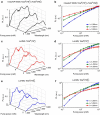Luminescent hyperbolic metasurfaces
- PMID: 28067219
- PMCID: PMC5473634
- DOI: 10.1038/ncomms13793
Luminescent hyperbolic metasurfaces
Abstract
When engineered on scales much smaller than the operating wavelength, metal-semiconductor nanostructures exhibit properties unobtainable in nature. Namely, a uniaxial optical metamaterial described by a hyperbolic dispersion relation can simultaneously behave as a reflective metal and an absorptive or emissive semiconductor for electromagnetic waves with orthogonal linear polarization states. Using an unconventional multilayer architecture, we demonstrate luminescent hyperbolic metasurfaces, wherein distributed semiconducting quantum wells display extreme absorption and emission polarization anisotropy. Through normally incident micro-photoluminescence measurements, we observe absorption anisotropies greater than a factor of 10 and degree-of-linear polarization of emission >0.9. We observe the modification of emission spectra and, by incorporating wavelength-scale gratings, show a controlled reduction of polarization anisotropy. We verify hyperbolic dispersion with numerical simulations that model the metasurface as a composite nanoscale structure and according to the effective medium approximation. Finally, we experimentally demonstrate >350% emission intensity enhancement relative to the bare semiconducting quantum wells.
Conflict of interest statement
The authors declare no competing financial interests.
Figures

 of the LuHMS results in collected emission polarized predominantly parallel
of the LuHMS results in collected emission polarized predominantly parallel  to the metacrystal Bloch vector, KB. The wavelength of peak emission and PL intensity depend strongly on pump polarization. Emission from the LuHMS blue shifts as the pump polarization changes from
to the metacrystal Bloch vector, KB. The wavelength of peak emission and PL intensity depend strongly on pump polarization. Emission from the LuHMS blue shifts as the pump polarization changes from  to
to  due to increasing pump absorption. In addition, PL spectra of the LuHMS differ significantly from that of control MQW, regardless of pump polarization, due to a wavelength and pump power dependence of the direction of energy propagation on the surface.
due to increasing pump absorption. In addition, PL spectra of the LuHMS differ significantly from that of control MQW, regardless of pump polarization, due to a wavelength and pump power dependence of the direction of energy propagation on the surface.
 and
and  pumping, respectively (b) Total PL spectra of the LuHMS for parallel and normal polarized pump. The shape of the spectra differ due to band-filling effects. (c) Pump PA of total emission calculated from b. The pump PA increases with frequency due to band-filling associated with the more efficiently absorbed pump polarization. (d) DOLP of emission for parallel-polarized pump. The DOLP is close to unity, indicating nearly linearly polarized light in the direction parallel to KB. Inset to d shows SEM of nanostructure and definition of polarizations.
pumping, respectively (b) Total PL spectra of the LuHMS for parallel and normal polarized pump. The shape of the spectra differ due to band-filling effects. (c) Pump PA of total emission calculated from b. The pump PA increases with frequency due to band-filling associated with the more efficiently absorbed pump polarization. (d) DOLP of emission for parallel-polarized pump. The DOLP is close to unity, indicating nearly linearly polarized light in the direction parallel to KB. Inset to d shows SEM of nanostructure and definition of polarizations.

References
-
- Landau L. D., Lifshitz E. M. & Pitaevskiî L. P. Electrodynamics of Continuous Media Pergamon (1984).
-
- MacKay T. & Lahktakia A. Electromagnetic Anisotropy and Bianisotropy: A Field Guide World Scientific (2010).
-
- Narimanov E. E. & Kildishev A. V. Metamaterials: naturally hyperbolic. Nat. Photonics 9, 214–216 (2015).
-
- Poddubny A., Iorsh I., Belov P. & Kivshar Y. Hyperbolic metamaterials. Nat. Photonics 7, 948–957 (2013).
-
- Smith D. R. & Schurig D. Electromagnetic wave propagation in media with indefinite permittivity and permeability tensors. Phys. Rev. Lett. 90, 77405 (2003). - PubMed
Publication types
LinkOut - more resources
Full Text Sources
Other Literature Sources

